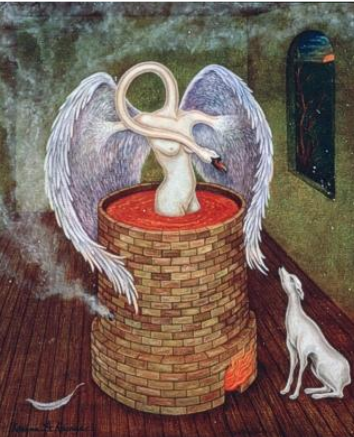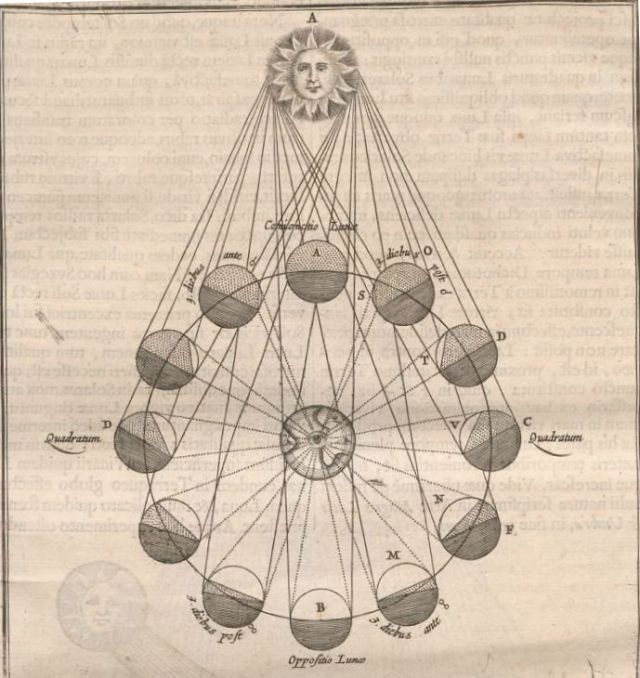Karena A Karras, “The Bath”
I.”The Zodiac & the Dying/Rising God
While the daily rising and setting of the sun told the tale of Atum -Re’s deadly boat journey, the moon’s monthly crescendo and diminuendo portrayed the myth of Inanna’s death and rebirth. But, after she rose from the Underworld, the goddess Inanna was warned that, if she hoped ‘to escape the pit alive, she must leave another who shall wait in her place.’
Henceforth, it was Damuzi, her shepherd-king and consort that descended into the dark Underworld. Though he passed through the same Mythologem of Death and Rebirth as Inanna, Damuzi descended, died and rose again yearly, with the seasonal cycle of rain and drought. Like Osiris in Egypt, Attis in Syria, and Baal in Canaan, the ‘Son of the Abyss’ became a new Iconologue of Time’s Measure, marking the span of the sacred year.
The dying/rising god marked the passage of a year by mythologizing the signs that recurred in the earth’s fertile cycle. Like the fertile seed at the time of the harvest, Damuzi was seized, thrashed and cut to pieces … And, like the seed buried under the earth so as to gestate and sprout again, he was dragged into the Underworld, where he remained – until the re-emergence of the crops themselves embodied his resurrection …
Each time the fields manifest new growth, the god of vegetation also became manifest. Through the image of the dying/rising god, the intervals of the fertile year were measured and, through his earthly epiphany, that span was rendered sacred. …
Meanwhile, a fascinating series of images have come down to us from Sumerian culture … This array of images, when taken together, also symbolizes the yearly cycle. From the vantage point of the spiraling ziggurats, the Sumerian priesthood were able to discern a multitude of ancient images in the night-sky.
Eventually, they learned to read the heavens like a book – which is what they called astrology, Shitir Shame, ‘The Book of Heaven.’ By following the path of Sin, the moon, over the course of the year, they recognized twelve celestial figures: Luhunga ‘the Hired Man’ (Aries), Guanna ‘the Bull of Heaven’ (Taurus), Mastabbagalgal ‘the Great Twins’ (Gemini), Allul ‘the Crab’ (Cancer), Urgula ‘the Lion’ (Leo), Absin ‘the Furrow’ (Virgo), Zibanitum ‘the Scales’ (Libra), Girtab ‘the Scorpion’ (Scorpio), Pabilsag ‘the Centaur’ (Sagittarius), Sahurmasku ‘the Fish-tailed Mountain Goat’ (Capricorn), Gula ‘the Great’ (Aquarius) and Kummes ‘the Tails’ (Pisces). Together, these twelve images formed, what the Greeks called, ‘the wheel of the Zodiac’ (from zôé, life, zôidion, small figure, and kyklos, circle or wheel, giving us zodiakos ‘the wheel of life’.)
Thus, in Mesopotamia, there were two iconologues to measure the passage of a year, one celestial and one terrestrial.”
Caruana, Enter through the Image: The Ancient Image Language of Myth, Art and Dreams, pp. 75-76
“Almost two thousands years before the circular zodiac of Bet-Alpha, Near Eastern rulers, especially in Babylon, invoked their Gods on treaty documents; boundary stones (Kudurru) were emblazoned with the celestial symbols of these Gods – planets and zodiacs – within the heavenly circle, embraced by an undulating serpent that represented the Milky Way” (via http://www.bibliotecapleyades.net/sitchin/whentimebegan/whentimebegan07.htm)
II.“The Moon … represents all raw materials, all elemental or psychic energies not yet organic or individuated. But it is not only the inorganic as such. It is the inorganic striving to become organized. It is the ‘woman’ yearning to be fecundated and to become a mother, longing for her ‘home’. It is not chaos; but rather, the response of chaos to light; an unsteady, changeful, moody response, now waxing, then waning — yet it is light nevertheless; as much of light as the resurgent past may mirror and reflect. And the Earth and all living things thereon are the temples where the song of light and the song of life resound. Light gives to men the will to be whole and integrated. Life gathers their chaotic soul-energies, churns them up, dissolves and boils them in the alchemical vessel in which may be generated the gold of consciousness and of individual selfhood.”
Dane Rudhyar, New Mansions for New Men: A Spiritual Interpretation of Astrology in the Light of Universal Symbolism http://khaldea.com/rudhyar/nmnm/nmnm_moon.php
III.“The Goddess is the Encircler, the Ground of Being; the God is That-Which-Is-Brought-Forth, her mirror image, her other pole. She is the earth; He is the grain. She is the all encompassing sky; He is the sun, her fireball. She is the Wheel; He is the traveler. He is the sacrifice of life to death that life may go on. She is the Mother and Destroyer; He is all that is born and is destroyed.”
Starhawk, The Spiral Dance: A Rebirth of the Ancient Religion of the Goddess: 20th Anniversary Edition, p. 72
Goddess Kali as Great Mother
















Wonderful thoughts. I awakened with wonderfully, deep, transforming, other worldly, dark, yet ever so hopefully wonderful thoughts. One must be courageous in the face of what must die. One must reach for the color(s) inherent in all myths. These are the same colors, that make up the threads of our lives. They become the fabric as back ground to the images that support us in the comings and goings of our everyday world. We are colored as in art, by the threads of our negative space. This degree of Scorpio bursts forth with the fire of a Ram all the while glowing in the darkness of Hades’ terrain. I say bow down to that which frightens yet by which you feel so utterly compelled. I’ve awakened just now at the moment of the eclipse at 0 degrees of Scorpio, guided as I slept apparently by Hades/PLuto and that Scorpio knowing. Image: There is color underneath and gold in them thar hills. Go forth with courage and mine it
LikeLike
Thank you so much, dear Judith, for sharing your message of courage in the face of deep transformation. “We are colored as in art, by the threads of our negative space.” – I love that! Thank you deeply.
LikeLike
There’s an interesting polarity in part III, that’s not so much oppositional, but symbiotic. Hopefully, I am not distilling the images down too much here, but I see the feminine as form from which the masculine content is brought forth. The feminine as verb to the masculine noun. Form and content, nouns and verbs, but it would be too simplistic to leave it at that, or to conclude that the feminine is then the creating force and the masculine the created being. But, perhaps we can see how the feminine more easily disappears as a forming force and the masculine tends to dominate our view out of sheer force of presence, or what is made manifest.
It still amazes me how the ancients used such powerful imagery to express truths of cosmological proportions.
Thanks as always Monika, for sharing such rich and inspiring images.
LikeLike
Dear Debra
I love your linguistic analogy – no wonder, right? It is not simplistic to me at all. I also love your thought about how the more visible aspect is more prominent while the hidden one goes unacknowledged. That reminded me of a pair of cards from the Tarot: the High Priestess and the Hierophant. She is the invisible spiritual force, he the visible one.
Much love to you, Debra.
LikeLike
Thanks for the info on the Tarot cards Monika. That is a world I know very little about, but I love finding correspondence anywhere it may be found.
Hugs,
Debra
LikeLiked by 1 person
Have a wonderful eclipse Monika.
LikeLike
I did, actually and hope you did, too. Thank you!
LikeLiked by 1 person
It was magical Monika~
LikeLike
Reblogged this on lampmagician.
LikeLike
Pingback: Three Thoughts for the Eclipse: Light Meets Life | lampmagician
As always, your mind and heart amaze me! 🙂
LikeLiked by 1 person
Thank you, friend. Sending love and gratitude your way.
LikeLiked by 1 person
That book “The Ancient Image Language of Myth, Art and Dreams”, is a wonderful piece of writing.. as is this post !
LikeLike
Yes, I totally agree about the book.
Deep gratitude,
Monika
LikeLiked by 1 person
Thank you for another beautiful and thought provoking post, Monika. To begin, I am so taken by your opening image of the Swan woman. It is captivating. Today I timed my lunch break from work so I could get to a place where there is a river, and stood near a fork in the river with a river fall at the exactitude of the eclipse. I am not able to express it here, but want to thank you for sharing the image of Damuzi with me as reading it now ties together some previous thoughts today. As always, you are divinely discerning in your selection of Rudhyar to quote, and the phrase of chaos responding to light is staying with me. I was intrigued and had to look up what spiraling ziggurats was referring to- Awesome.
gratefully, Gray
LikeLiked by 1 person
Dear Gray,
Thanks for a wonderful and “divinely discerning” comment. You have been spoiling me with those lately. I remember your post about the swan, and I knew you would appreciate that image. I have found it on the website I often browse through: http://www.alchemywebsite.com/
Incidentally, one of my favourite architects is Frank Lloyd Wright (born 8 June 1867), and one of his most famous creations is an inverted ziggurat:
http://www.guggenheim.org/new-york/about/frank-lloyd-wright-building
Thank you deeply,
Monika
LikeLike
Monika, I so enjoy your posts. They are extremely informative and also deeply inspiring. This one I find absolutely fascinating. Thank you for informing and inspiring me. 🙂
LikeLike
Don – thank you so much. I did spend a considerable amount of time putting the quotes together and thinking of their proper arrangement, but with feedback like this it is always worth it.
LikeLike
Love the post, but something about “The Bath” painting is unsettling. I feel like it is tapping into some hidden part of my consciousness.
LikeLike
Hi Jeff! Unsettling is fitting for the eclipse. I thought you liked “horror.” 🙂 Thanks for leaving a comment.
LikeLike
Ha Ha! I do, and feeling unsettled is not a bad thing. Just pointing out that I had a visceral response to it, which means it’s powerful art, imho 😉
LikeLiked by 1 person